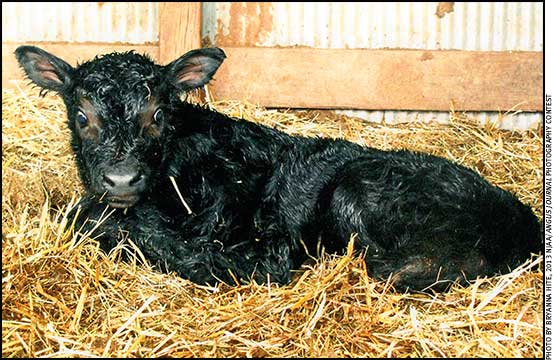HEALTH & NUTRITION...

Get a Newborn Calf to Breathe
There are traditional practices and old wives tales about how to get a newborn calf to breathe. Some are valid, and some are not.
Cody Creelman, veterinarian with Veterinary Ag-Health Services, a five-veterinarian beef cattle practice at Airdrie, Alta., Canada, says a few traditional practices to get newborn calves to breathe are actually harmful, even though they were recommended by veterinarians in earlier times. For instance, stockmen traditionally held the calf up by the hind legs to theoretically allow fluid to drain from the airways. Likewise, swinging the calf was supposed to help clear the airways.
“This is no longer standard practice. You’ll see fluid coming from the calf’s mouth and nose, but it’s been proven that this is fluid from the stomach. Hanging upside down or swinging actually makes it harder for the calf to breathe because of all the weight of the gut putting pressure on the lungs,” says Creelman. Read more.
Minimize Cold Stress with Windbreaks and Feed
Cattle in good body condition can withstand severely cold temperatures — if they have a little help.
The two most important aspects of cold-weather care for cattle are adequate feed and shelter from wind. If cattle have adequate nutrition and are in good body condition, they have more insulation against cold and enough energy to keep warm.
“The part of the diet we focus on is energy during cold weather,” says Russ Daly, Extension veterinarian and associate professor at South Dakota State University. “Protein is really important, too, but energy for calves is crucial. Weaning-age calves need a high-energy diet that usually includes grain. Producers here in the Northern Plains also recognize that cattle increase their intake in response to the cold,” he says.
Daly says cattlemen have to be sure they are providing the additional feed cattle need. For animals with a functional rumen — older calves, adult cattle — having adequate protein to utilize the energy is important. Microbes in the rumen break down roughage in forage into useable energy, but they need protein to do this. Read more.
Making Sense of Forage Analysis Results
This year’s forage analysis can help improve next year’s harvest.
Results from forage analyses aren’t just for ration formulations. The numbers can also help producers adjust management processes to avoid future problems altogether.
“The results of forage analysis can be really useful,” says Bob Charley, forage products management, Lallemand Animal Nutrition. “For instance, it can show if the crop was harvested correctly or if silages are prone to spoilage.” Read more.
Alfalfa Loss? Annual Ryegrass is a Win
Annual forage crops offset losses from alfalfa winterkill.
Meet alfalfa, a perennial legume used mainly as high-quality feed for dairy cattle. Alfalfa is also used as feed for beef cattle, horses, sheep and goats. It’s high in protein (16%-20% crude protein). It contains a lot of calcium and other minerals and vitamins. It contributes billions of dollars to the United States economy annually.
Alfalfa faces a cold challenge.
In the United States, alfalfa is grown mainly in western and northern states. The cold winters and other factors in many of these states can damage alfalfa crops. That can lead to losses for farmers and forage shortages.
Researchers at the University of Minnesota are working to help farmers offset losses caused by alfalfa winterkill. They are trying to identify annual forage crops that can be cultivated in fields with winter-killed or terminated alfalfa. Read more.
Benefits of Growing Multiple Types of Forage Grasses
Cattle prefer a buffet to a one-course meal.
Although it might seem like grazing animals will eat any grass in the field, they are actually picky eaters. They prefer a “buffet” of grass choices. While it’s good for the grazing animals, growing a variety of forage plants in the field also benefits the plants, the soil and the environment.
Grazing animals spend most of their grazing time making decisions about what to eat with every bite. Luckily for the animals, they don’t normally have only one option for their meal in a pasture setting. Growing multiple plant species in the same space at the same time, polyculture, is the norm in pasture grazing scenarios. Read more.
Cattle Diseases: Common Conditions/Terms
Click here for a list of common conditions and terms related to beef cattle diseases, such as anaplasmosis, brucellosis, BVD, E. coli, IBR and others.
[Click here to go to the top of the page.]






